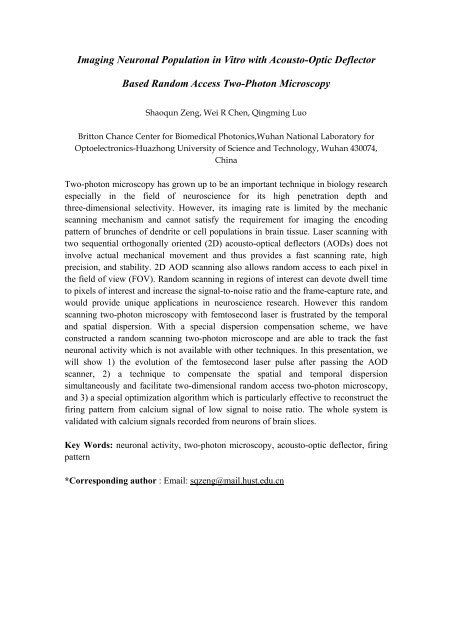New Modes of GPCR Signalling
New Modes of GPCR Signalling
New Modes of GPCR Signalling
Create successful ePaper yourself
Turn your PDF publications into a flip-book with our unique Google optimized e-Paper software.
Imaging Neuronal Population in Vitro with Acousto-Optic Deflector<br />
Based Random Access Two-Photon Microscopy<br />
Shaoqun Zeng, Wei R Chen, Qingming Luo<br />
Britton Chance Center for Biomedical Photonics,Wuhan National Laboratory for<br />
Optoelectronics-Huazhong University <strong>of</strong> Science and Technology, Wuhan 430074,<br />
China<br />
Two-photon microscopy has grown up to be an important technique in biology research<br />
especially in the field <strong>of</strong> neuroscience for its high penetration depth and<br />
three-dimensional selectivity. However, its imaging rate is limited by the mechanic<br />
scanning mechanism and cannot satisfy the requirement for imaging the encoding<br />
pattern <strong>of</strong> brunches <strong>of</strong> dendrite or cell populations in brain tissue. Laser scanning with<br />
two sequential orthogonally oriented (2D) acousto-optical deflectors (AODs) does not<br />
involve actual mechanical movement and thus provides a fast scanning rate, high<br />
precision, and stability. 2D AOD scanning also allows random access to each pixel in<br />
the field <strong>of</strong> view (FOV). Random scanning in regions <strong>of</strong> interest can devote dwell time<br />
to pixels <strong>of</strong> interest and increase the signal-to-noise ratio and the frame-capture rate, and<br />
would provide unique applications in neuroscience research. However this random<br />
scanning two-photon microscopy with femtosecond laser is frustrated by the temporal<br />
and spatial dispersion. With a special dispersion compensation scheme, we have<br />
constructed a random scanning two-photon microscope and are able to track the fast<br />
neuronal activity which is not available with other techniques. In this presentation, we<br />
will show 1) the evolution <strong>of</strong> the femtosecond laser pulse after passing the AOD<br />
scanner, 2) a technique to compensate the spatial and temporal dispersion<br />
simultaneously and facilitate two-dimensional random access two-photon microscopy,<br />
and 3) a special optimization algorithm which is particularly effective to reconstruct the<br />
firing pattern from calcium signal <strong>of</strong> low signal to noise ratio. The whole system is<br />
validated with calcium signals recorded from neurons <strong>of</strong> brain slices.<br />
Key Words: neuronal activity, two-photon microscopy, acousto-optic deflector, firing<br />
pattern<br />
*Corresponding author : Email: sqzeng@mail.hust.edu.cn












